Finding Insects and Other Mini-Beasts in your garden
by Andy Marquis
I
have re-written this slightly such that I hope it will be useful to
parents and others who now have their children at home with them
due to school closures during the Covid-19 pandemic. It may
be alittle wordy but there are lots of links (any underlined
word) taking you to photo galleries.
Your garden is one of the most important habitats for mini-beasts. A garden has all of the food and shelter that they need with compost heaps, piles of leaves or logs, damp corners, rock gardens, ponds, trees and hedges. There are insects which use all of these and though you might not know it, they are in many cases helping to keep your garden healthy, eating pest species, breaking down leaves and detritus into compost and controlling weak plants.
The world evolved without the use of herbicides and pesticides as nature provides all of the wild species which in their niche habitat perform a vital function. It is only when some of these are removed that things start to go wrong.
This article aims to provide some knowledge and insight into what you can find in a very normal Guernsey garden, how you can find and identify some of the inhabitants and more importantly how you can protect them, encourage them and enjoy them.
Where can you look for mini-beasts?
There are plenty of micro-habitats in your garden. Each one of them should have plenty of insect life:
-
Leaf litter
-
Under rocks (either tight to the ground or loose allowing insects underneath)
-
Under old logs (as above)
-
Compost heap or bin
-
Under plant pots (looking under plant pots on a patio is a great place!)
-
In the rockery
-
On trees and in hedges
- In bushes (even
ornamental ones provide shelter)
What mini-beasts might you find?
-
Collembola (aka Springtails)
-
Many more other species like the moths, flies, wasps, ladybirds, leafhoppers, crickets and grasshoppers, groundbugs, shieldbugs, spiders etc etc
The healthier your garden, the more you will find both in the number of different groups and the number of individual species within those groups.
What equipment might I need?
Luckily, it’s really easy to look for mini-beasts in the garden, you don’t need anything at all to look for most of them. Just turning an old log will reveal lots of them, you can however find more of interest with a few simple tools:
-
A hand lens (a few pounds off eBay or similar) to view your finds, one with a built-in light is a good idea.
-
A clean cat litter tray, preferably white or a light colour (for sorting through leaf litter and compost or holding under bushes to knock things out, even just to hold things like centiedes for a closer look before they skuttle off)
-
A soil sieve (available at good garden centres) to sieve leaf litter etc, you can easily manage without one, just shake leaves through your fingers and remove larger ones from the tray (give them a tap over the trap first do dislodge anything hanging on) so that your catch can't hide from you.
-
A stout stick (use this to knock a branch when holding a tray underneath and mini-beasts will fall into the tray)
-
Some pots to temporarily hold mini-beasts (clear plastic pots with screw lids are best but anything will do, clear is better)
-
It is possible to go more in depth into certain groups such as moth trapping, pitfall traps for beetles or a malaise trap for flying insects but this intends to be a general introduction.
How do I go about looking?
First things first, it’s always nicer if it’s dry outside, mini-beasts don’t like being in wet trays. Cold weather is fine though, I have found loads of cool mini-beasts in the depths of winter, it’s one of the best times to be looking! If it's wet outside, slugs and snails will be active, see how many you can find.
Leaf Litter:
Most gardens have a quiet corner where leaves gather having been blown by the wind. This is great news as all manner of creatures will use this to feed on and process your leaves. Most of those creatures you find in leaf litter are processing it to turn it into compost so they are the good guys! The good guys are predated by other mini-beasts so expect to find beetle larvae as well.
Get a good handful of leaves, include some of the soil underneath, and pop them in a bucket. You can then either slowly look through a bit at a time putting a handful into a tray and manually working through or you can use the sieve method. Hold a soil sieve (the holes should be around 7mm or so, not too small) over a cat litter tray, add leaf litter and give everything a gentle shake. We don’t want to harm anything so not too rough (young children might need some supervising here). Lots of things will drop out of the leaves through the sieve and into the cat litter tray.
This is where it can get interesting, many of the things in leaf litter like to jump. A lot. You have been warned!
More advanced searches might make use of a tulgren funnel, but I will leave you to Google that one.
Under rocks and Logs (or old bits of wood or tiles etc):
This one is quite simple, find a nice rock or log and gently turn it over, you might need to be ready with a pot to capture some of the faster moving species as they make a dash for freedom. Most of these species will be easily visible as they run for cover, but there are also some you might want to take the time to look for. Pseudoscorpions are masters of disguise holding very still until they think the danger has passed. Always check the under side of rocks and wood for them, they are quite small so check carefully.
It is also worth checking through the surface layer of loose soil under rocks for more interesting finds such as the rarer species of woodlouse, like the ant woodlouse. If you turn over a rock which has ants, always check carefully for the small white ant woodlouse which lives in ant colonies.
The Compost Heap
There’s no need to go rooting round in the slimy not yet processed parts of the compost but that is where you will find some mini-beasts working their magic turning your unwanted fruit, veggies and grass clippings into soil.
You can always look in the cleaner more processed parts and you will be surprised how much life is in there. Compost heaps also hold a higher temperature than the surrounding area so allow more insects to keep hard at it processing your waste right through the coldest weather. Treat the compost in a similar way to processing leaf litter and you won’t go far wrong.
Plant Pots:
If you think you have nowhere for mini-beasts in your garden, this is where you will find them. Have a few plants on the patio? Well check under those plant pots! Centipedes, woodlice, Pseudoscorpions, Springtails, they are all there! Careful you don’t break the pots!
In the Rockery:
Parental help advised here! You don’t want to take the whole rockery apart, though I bet you will find some nice mini-beasts if you did!
The looser rocks are the best bet, just check underneath for woodlice and other mini-beasts.
On trees and in hedges:
This is where some of the "highly specialised" equipment listed above comes into its own. Hold the cat litter tray under the tree/bush and give it a sharp tap with the stout stick and see what falls out into the tray. If you are lucky you will get some ladybirds, caterpillars, collembola and who knows what else! Conifer hedges are particularly good for this.
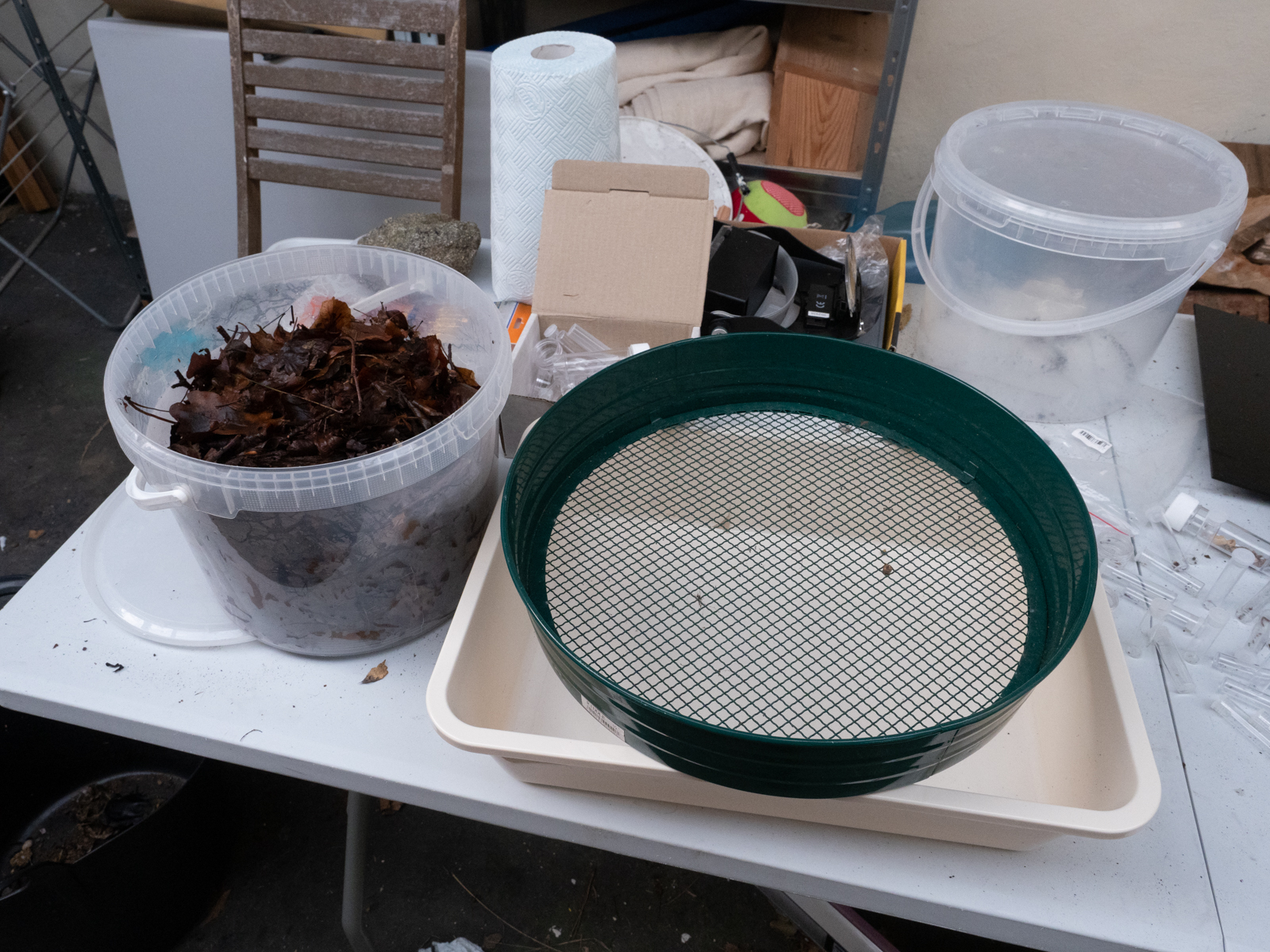
Leaf litter sorting, you don't need a sieve, just shake the
leaves over a tray and remove the larger bits by hand.
Some information about the easier to identify mini-beasts you might find:
Pseudoscorpions
What is a pseudoscorpion? Well first up they aren't scorpions, the clue is in the name which means false scorpion. They are not dangerous in the same way and cannot harm humans. They are part of the arachnid family (same as spiders) but look like a scorpion without the stinging tail hence being called false scorpions.
You can search for them in leaf litter, old logs, old birds’ nests (make sure you wait until the nest is finished with!) and on tree trunks. They hunt Collembola (springtails) and mites which they catch and inject with a tiny amount of venom from their mouthparts.
The biggest ones in the UK grow to about 5mm in length so nothing huge is likely to be found here. They generally live like most other small invertebrates, unseen and unknown by the vast majority of people.
So far, my garden has yielded 3 species:
-
Chthonius ischnocheles
-
Chthonius tetrachelatus
-
Roncus lubricus
The search continues as there are old records on the database at the Guernsey Biological Records Centre for species which I have not yet found so I need to get looking.
A full identification to species level isn’t always easy with these as there are some similar species with often microscopic ID points.
If you do find one in Guernsey please let me know as I would love to have a specimen (alive preferably) to identify and photograph. They can be held for a time in a specimen tube or a lidded box. It needs to have a lid as they are happy to walk up the side of anything and any air holes need to be small enough that they can't wonder out.
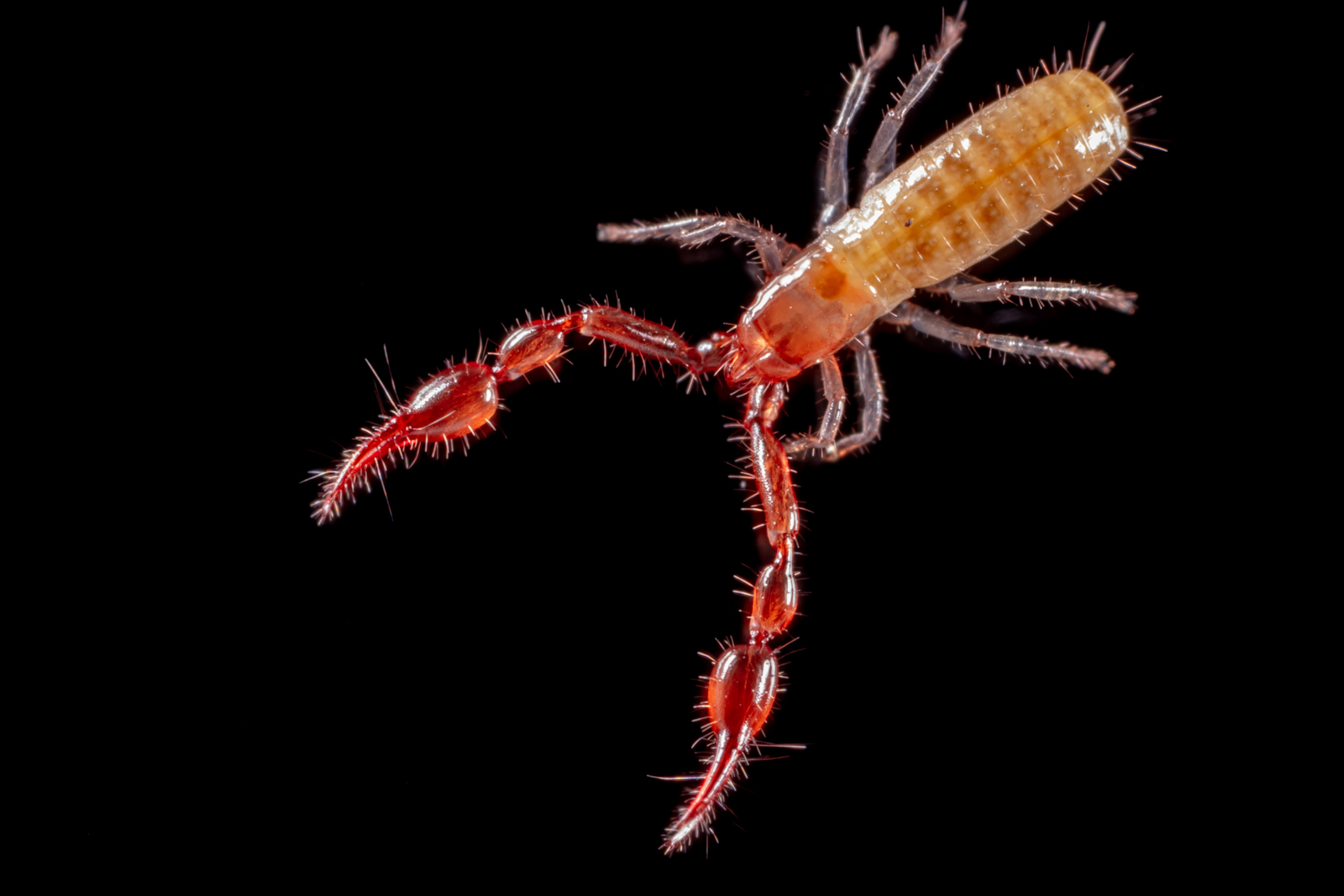
Roncus lubricus
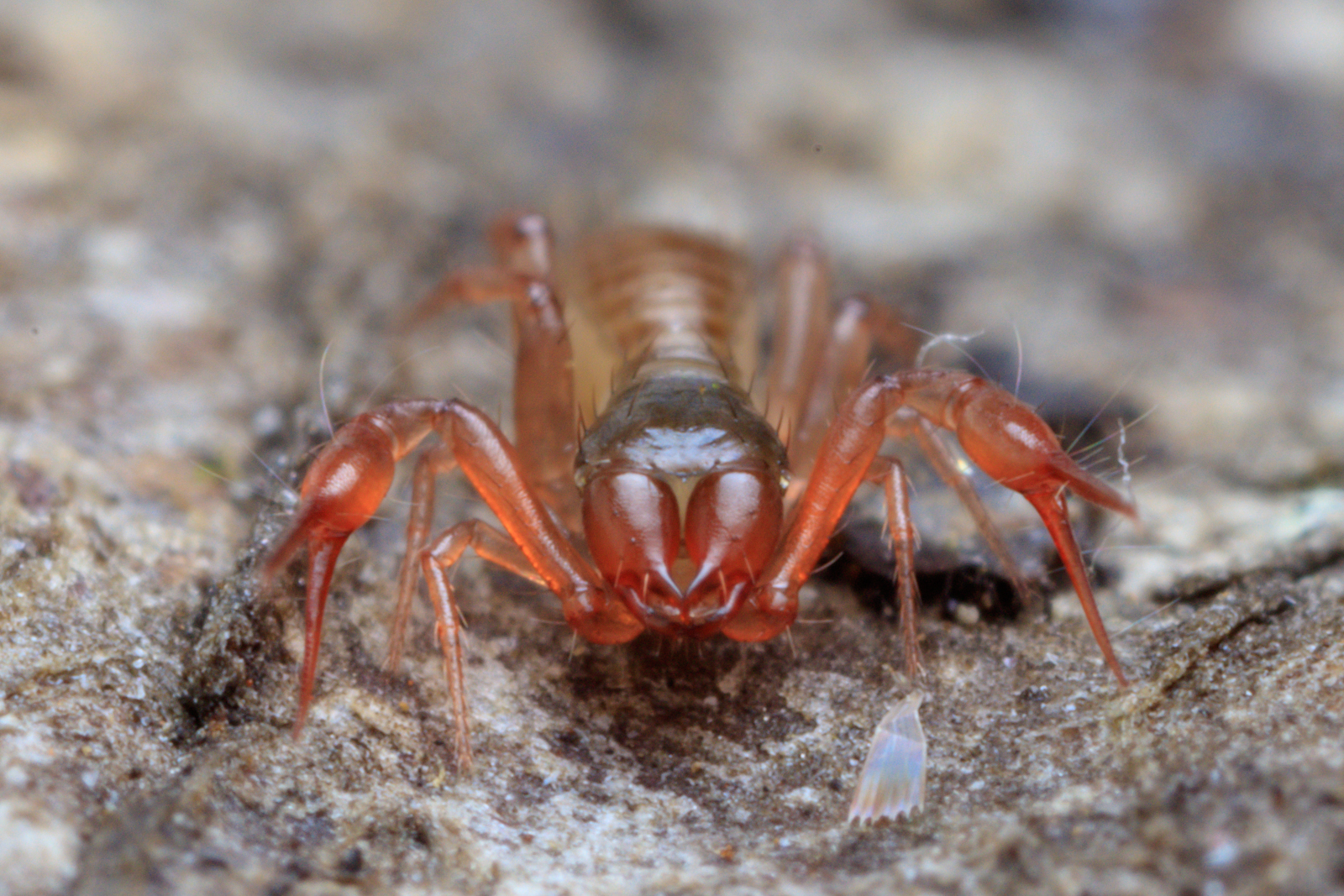
Chthonius ischnocheles
Collembola (aka Springtails)
The Collembola are the most common mini-beast you will find when searching as detailed above. There are many different species. At last count there were 33 species in the modern records for Guernsey (i.e. last few years, not very old records from decades ago).
Collembola can be found in all sorts of environments, most commonly in leaf litter but also in detritus from rotting wood, compost and soil samples. Some species are clearly widespread and common whilst others seemed to prefer areas of specific habitat, some specialist, some generalist, as you might expect.
The majority of springtails are between 0.5mm and 2mm long with some of the larger species such as Orchesella cincta as long as 5mm plus the large and cool, long twirly antennae of Pogonogathellus longicornis.
Some species are very common and easy to get a fairly certain ID. Others require microscopic views to identify them to species level. The easiest split is between the Symphypleona Collembola (round blob shaped ones) and the more elongate Arthropleona which includes the more commonly found Entomobryoidea family. There are no real common names in this group. I think it’s great for Children to be brought up using scientific names. It will help them in the future!
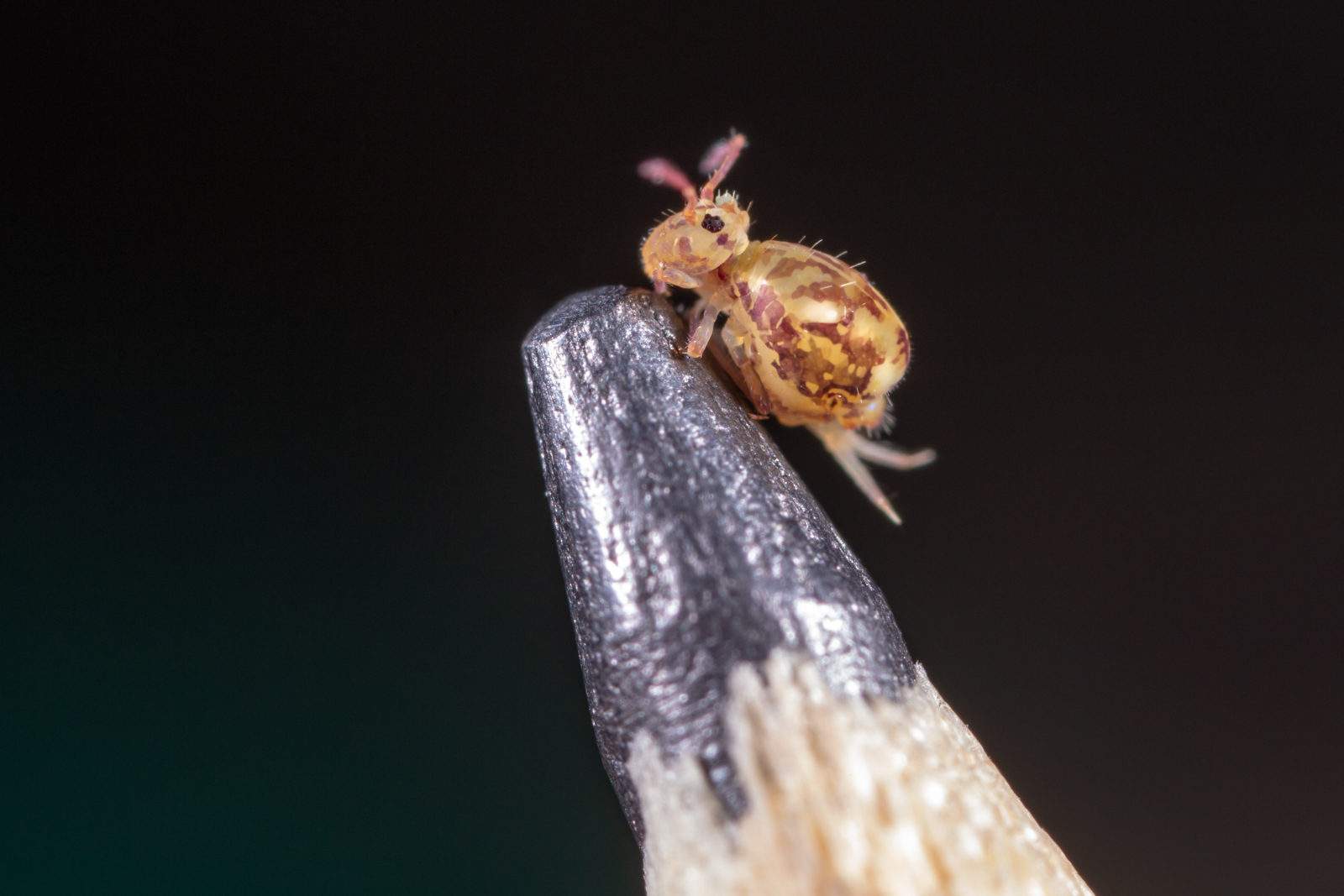
Dicyrtomina saundersi on my pencil
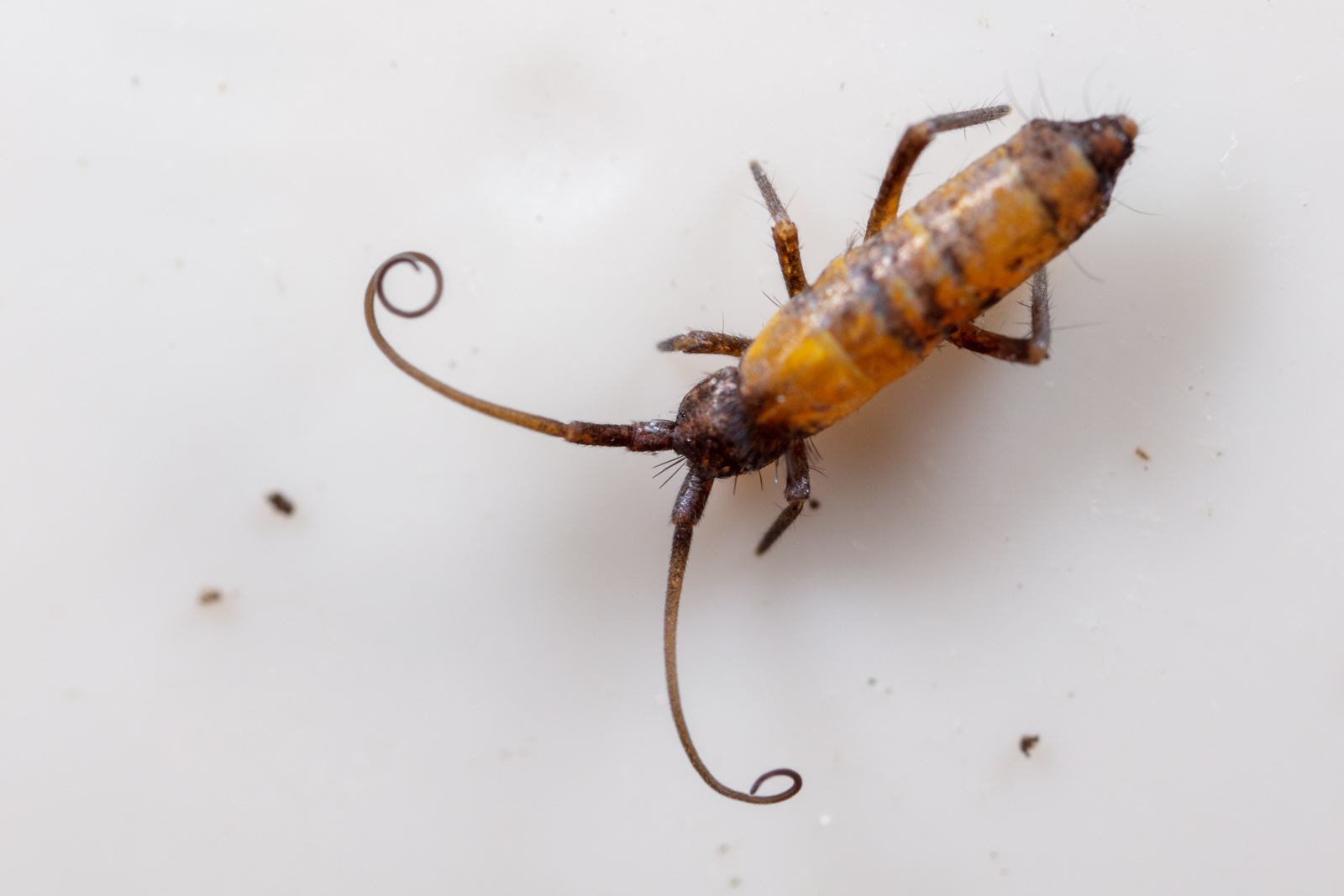
Pogonogathellus longicornis
Woodlice
Many people will know that they see lots of woodlice, but I imagine that the vast majority are all the same species, Porcellio scaber. There are in fact 40 species of woodlice in Britain. My personal list for Guernsey is currently at 16 species and there are no doubt plenty more to be found.
I have also found one which is new to the UK but with only photographs, it can’t be officially claimed as a specimen needs to be examined by an expert for that to become official. So if you happen across a hairy woodlouse, it could be one of the Chaetophiloscia species which should be retained alive for closer examination.
The main species you will come across, in order of how common I have found them to be in my garden are:
-
Porcellio scaber
-
Philoscia muscorum
-
Oniscus asellus
-
Armadillidium vulgare
-
Platyarthrus hoffmannseggi
However, there are others you are likely to come across. Woodlice are generally pretty easy to identify until you find the small ones and that’s when it all gets tricky and a microscope is required.
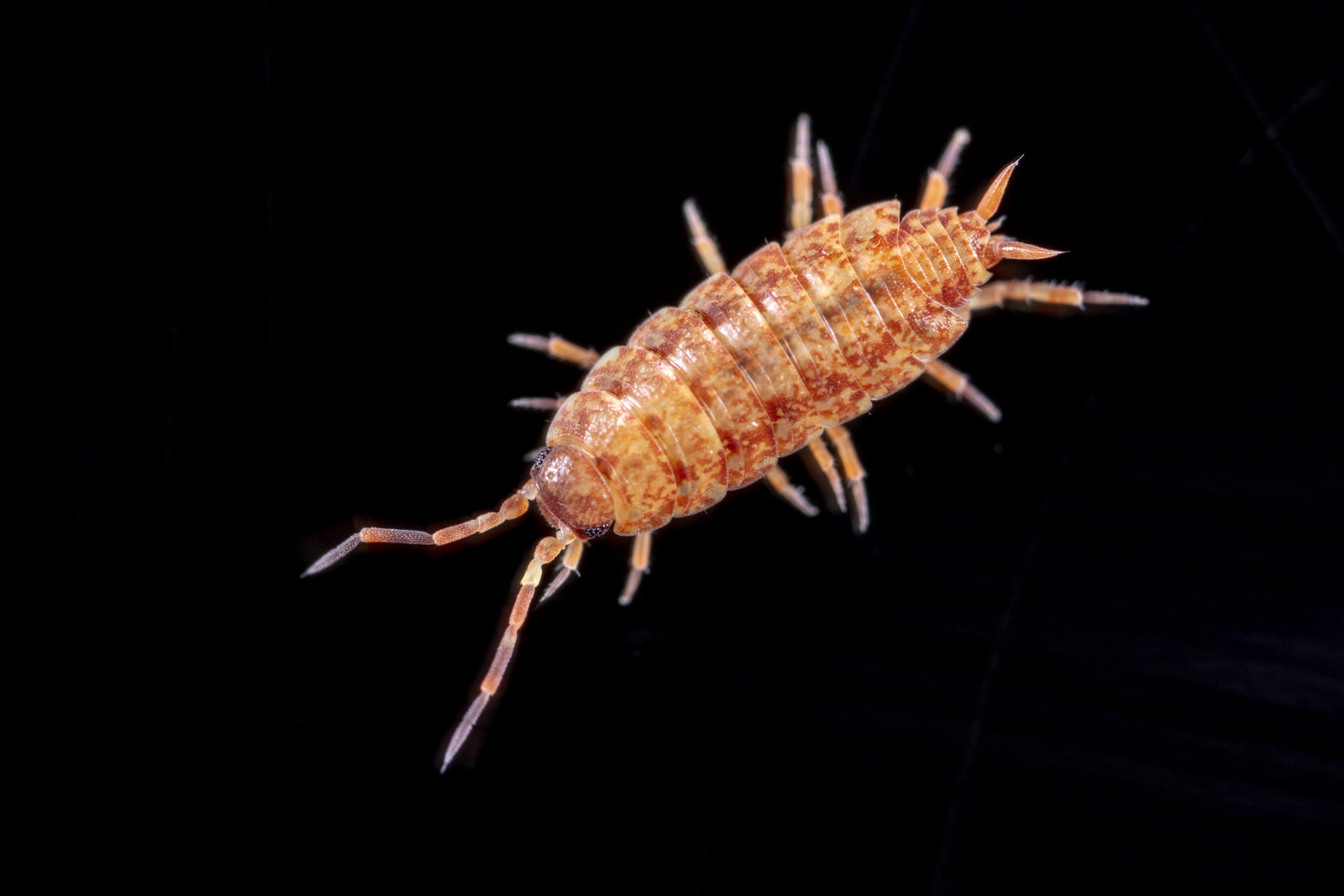
Porcellionides cingendus
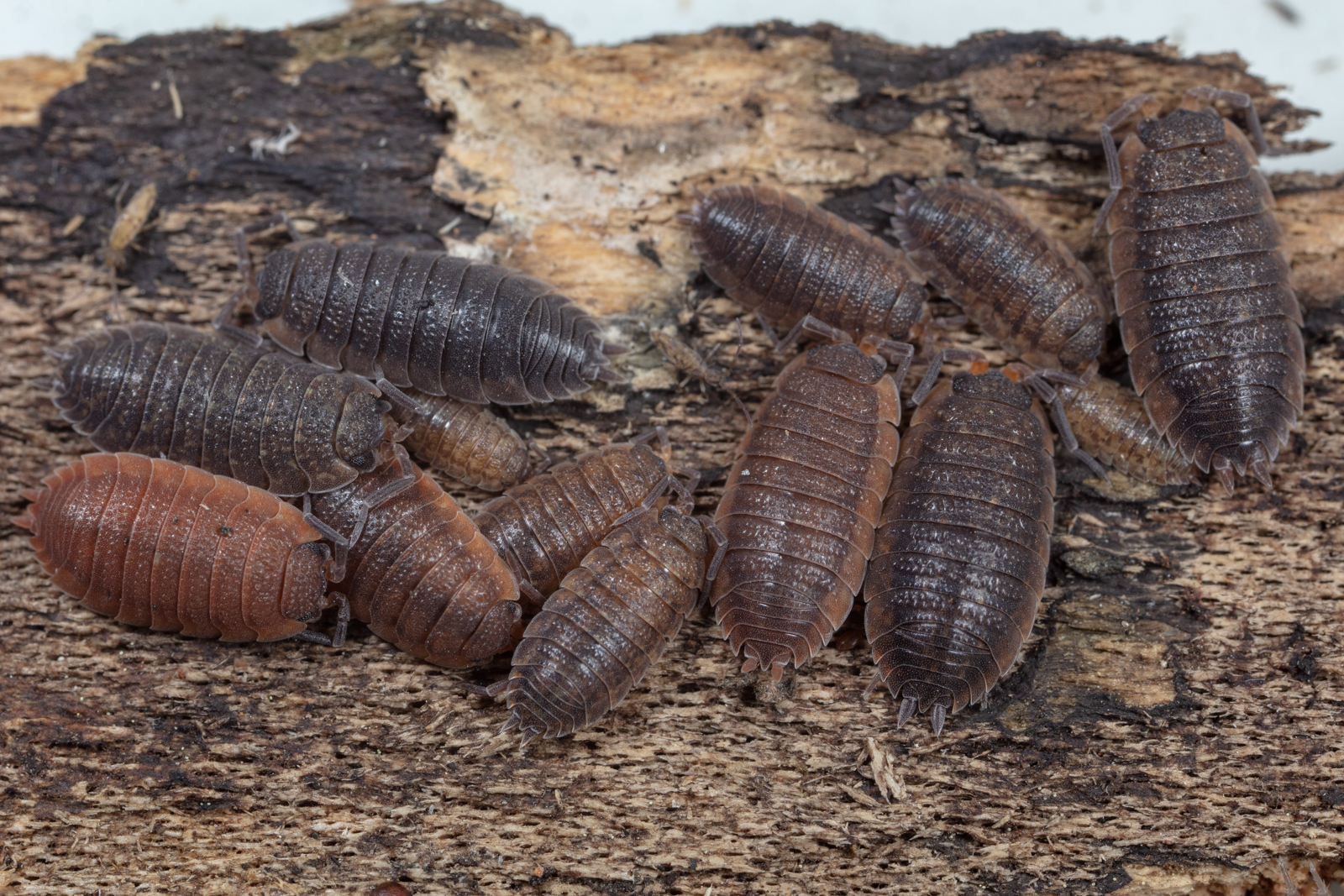
The most common woodlouse - Porcellio scaber

Ant Woodlouse - Platyarthrus hoffmannseggii
Harvestmen
Many people will see these as Daddy Long Legs. This is an example of the problems with using common names which is why I encourage scientific names when you are learning. When you say you have found a Daddy Long Legs, are you talking about Harvestmen, Crane Flies or Cellar Spiders?
In reality they are part of the arachnid family and come in all shapes and sizes, some with really short legs and some very long, some with tiny circular bodies and others large elongated ones.
The key difference to spiders, and the easy way to tell if you are dealing with a harvestman, is that they only have one body section and the eyes sit atop the body often on a small projection. Spiders have two body sections. Harvestmen also do not have any venom and are not able to spin silk.
Whilst there are some 30 species on the UK list, the Guernsey list currently consists of 11 species including historic records. One of those having been discovered new for the British Isles in 2019 in Guernsey.
They can be found in leaf litter especially the wonderful Nemastoma bimaculatum. They can also be found resting on garden walls, tree trunks and branches. It’s well worth popping outside and night when they are more active and they can be observed easily on garden and house walls.
There are some species which are more common than others. I see quite a few Dicranopalpus species. It’s only recently been confirmed that D.ramosus and D.caudatus are both present in the UK and therefore assumptions cannot be made in identification of them, add to this my discovery of D.larvatus and there are now three Dicranopalpus species to find. D.larvatus is smaller bodied than the others and the two tone colour pattern is fairly distinctive.
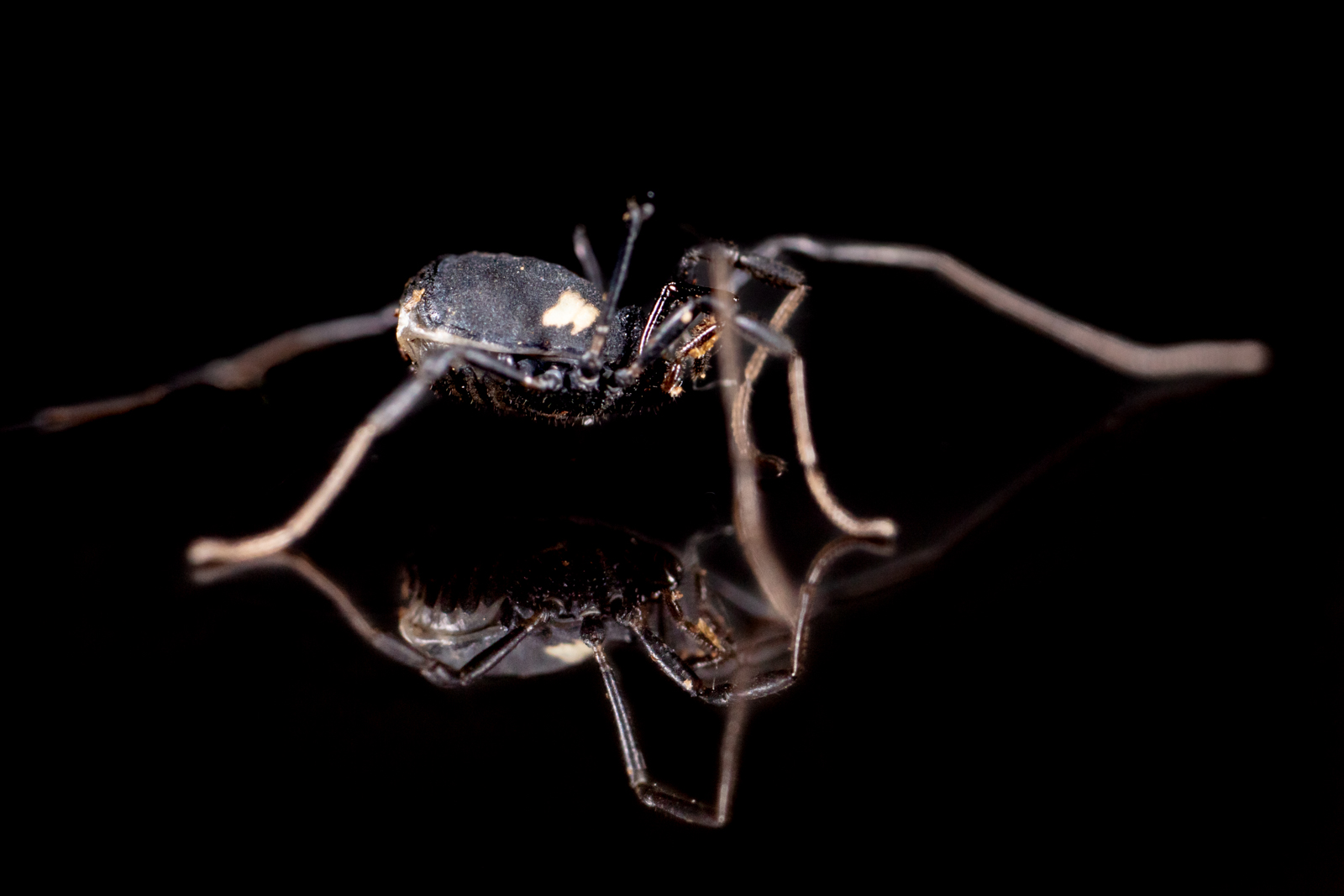
Nemanstome bimaculatum
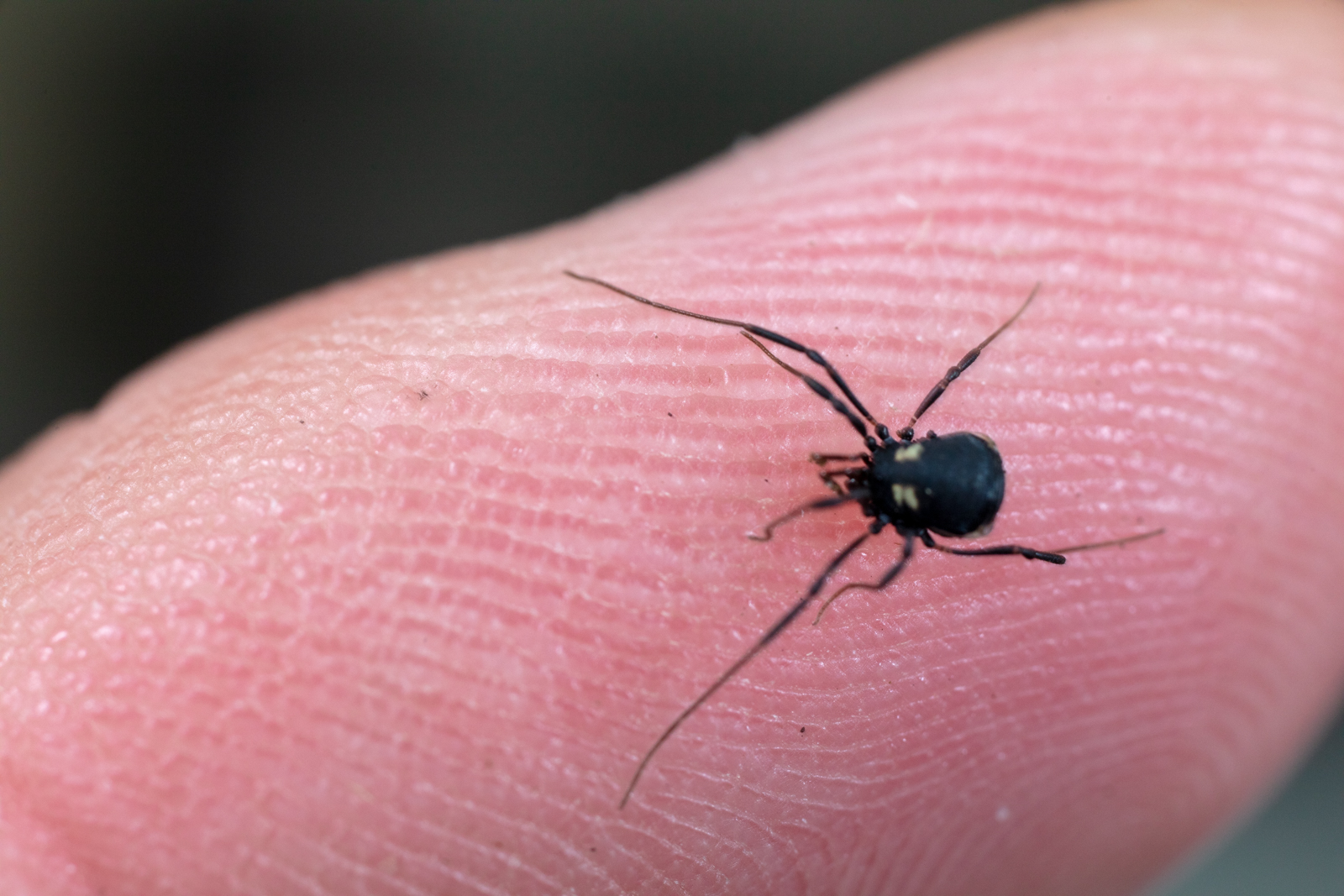
Nemanstoma bimaculatum on my finger, they are quite small.

Dicranopalpus larvatus
Centipedes and Millipedes
Small millipedes are very common in leaf litter and you will see them often.
The more interesting may well be the larger Lithobius centipedes which are some of the largest centipedes you will see on the island.
The two main species you will come across in the garden are Lithobius variegatus with its stripy purple back legs and Lithobius melanops.
Check under rotting logs or plant pots where you will find them hunting other insects.
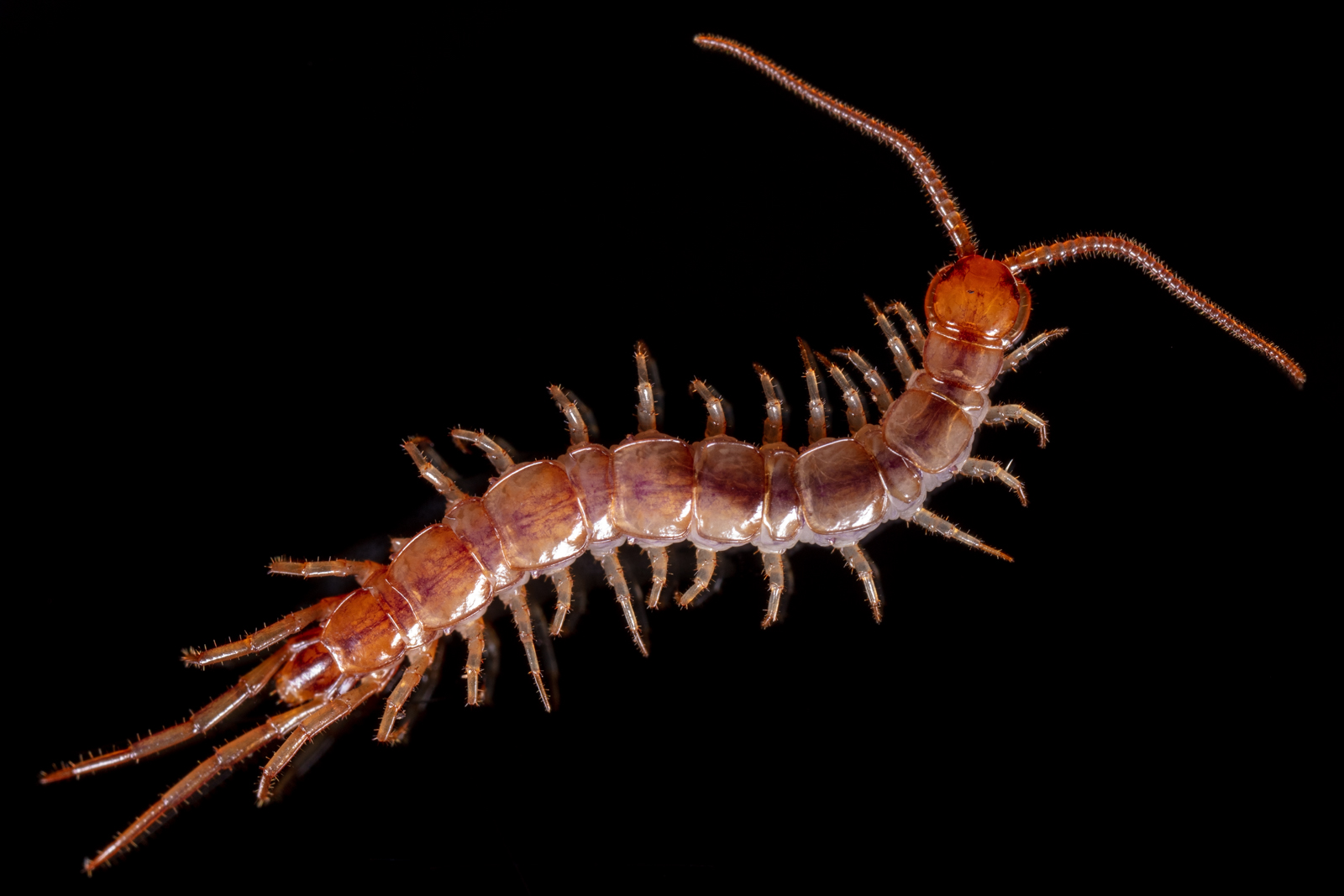
Lithobius melanops
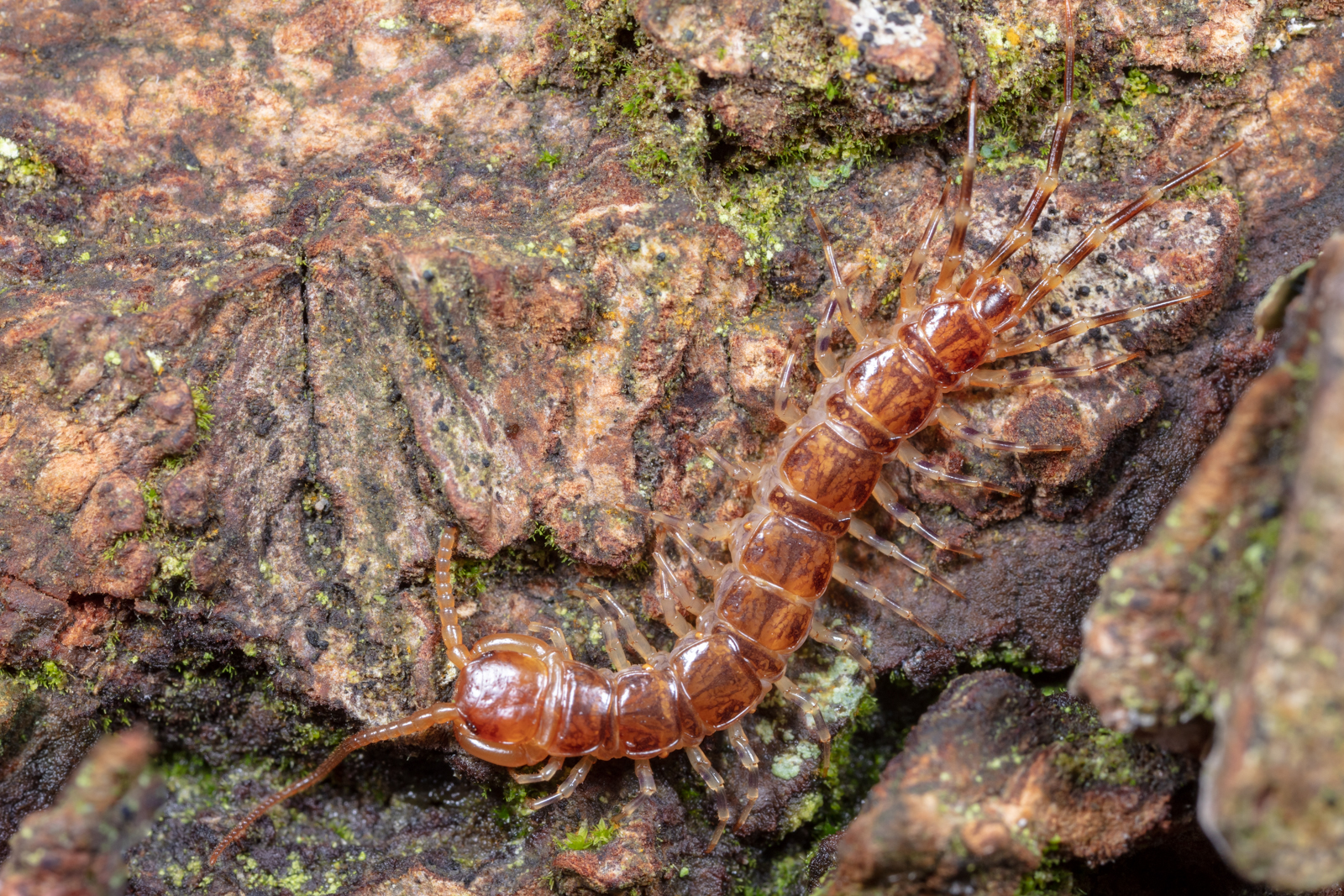
Lithobius variagatus
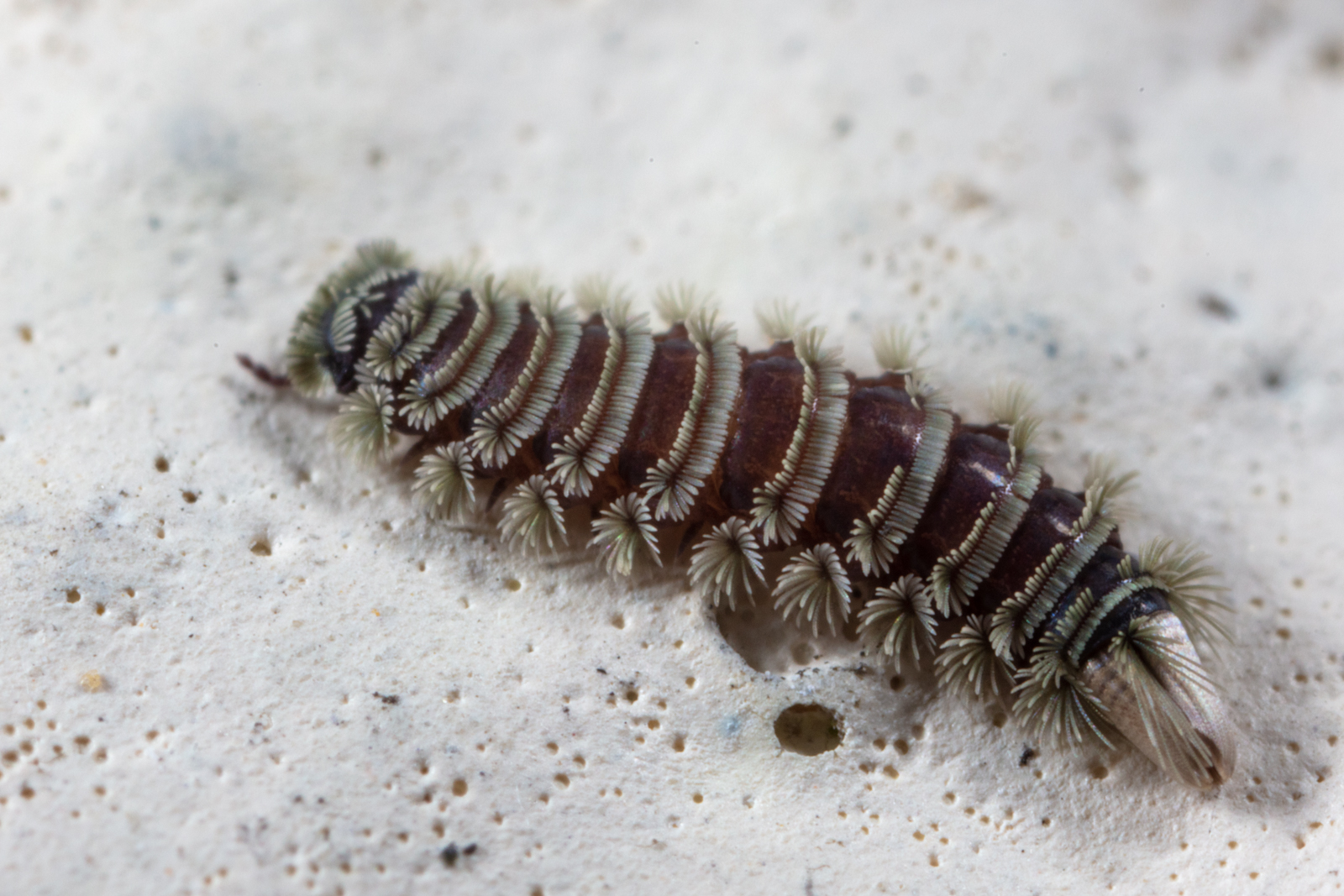
Bristly millipede
Other mini-beasts you will come across
-
Spiders
-
Beetles (many beetle larvae)
-
Slugs
-
Snails – watch out for the very smart hairy ones!
-
Larvae

Beetle Larva
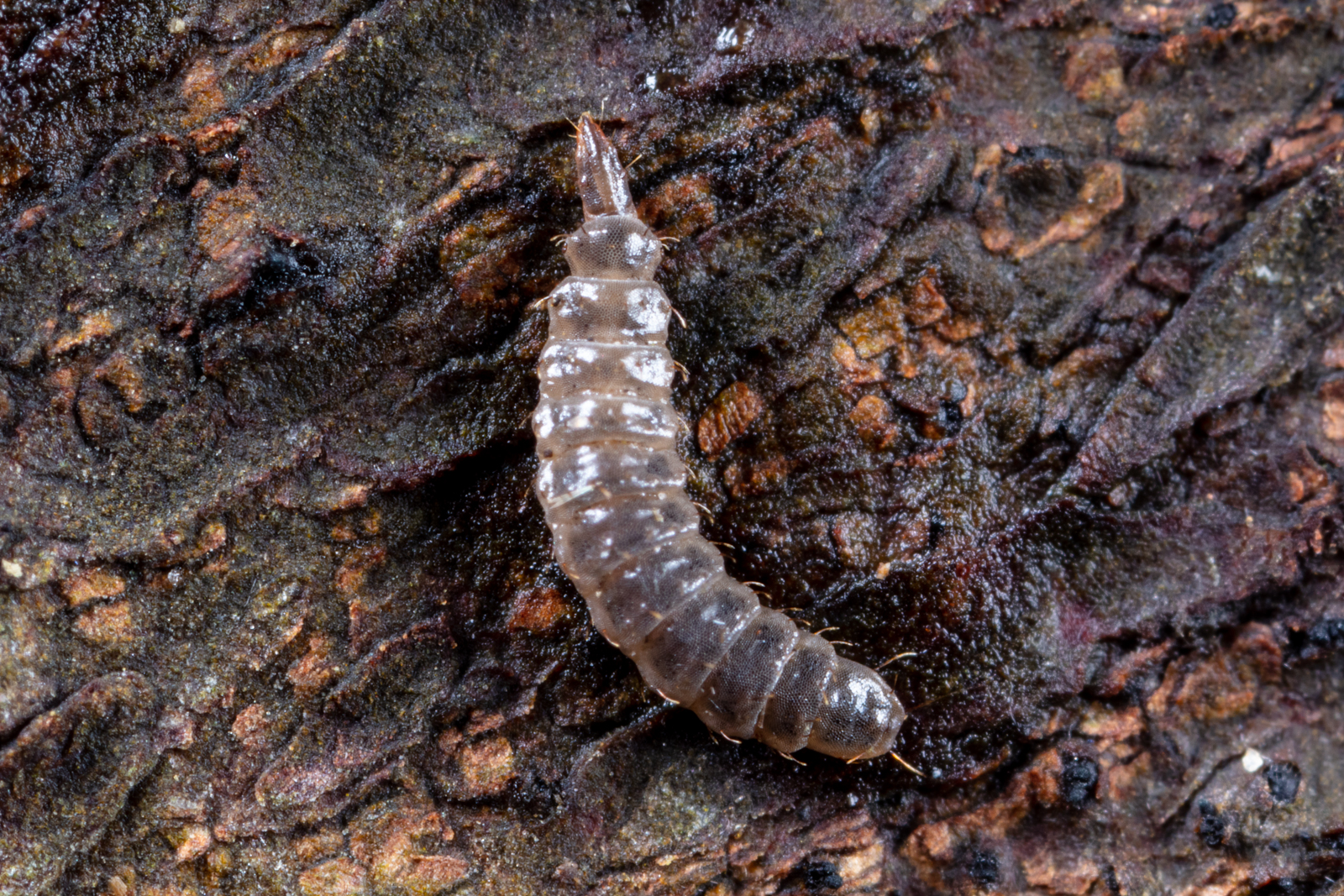
Diptera (fly) Larva
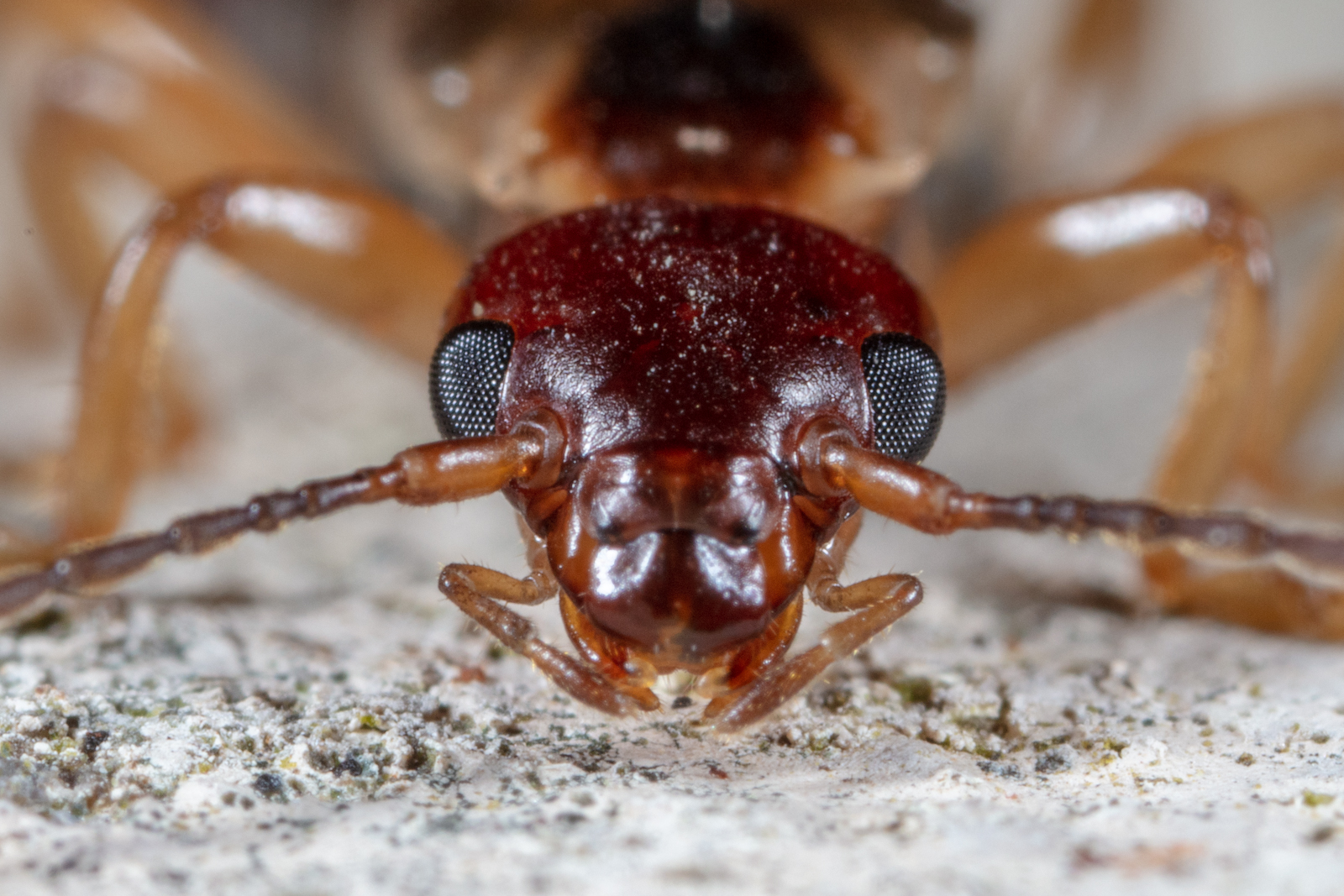
Earwig
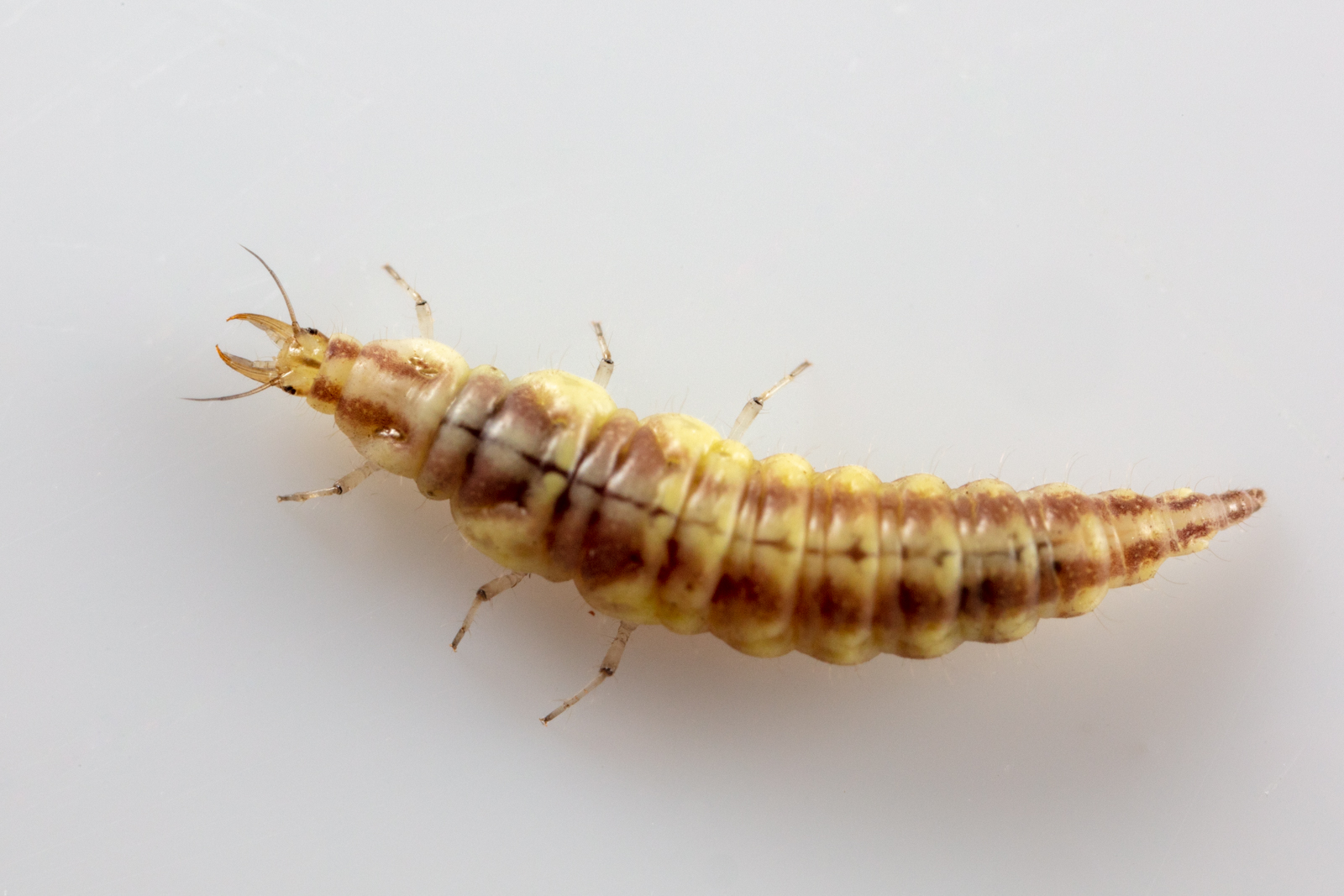
Lacewing larva
The Photography
I rely on my photography to assist with identification of the mini-beasts I come across.
Once you have been working with a group of insects for a while you get to know what to look for and which features you need to get good photographs of in order to assist with later identification. With woodlice for example, you need a close up of the antennal flagellum (the end section of the antenna), a side on shot showing the eyes (for those which have eyes!), an overall shot from above and photos of the back end from above and below. This will identify most of the more common species. All the angles need to be in focus and clear.
I use a variety of equipment to capture photographs of the small creatures including a Canon DSLR with specialist macro lenses which allows up to 5:1 magnification without attachments.
My workhorse though is a very specialist lens which cannot focus on anything further than 4 inches away, it is for macro photography at 1:1 and greater only. Specially designed for anything less than about 30mm long.
This will all seem a bit specialist to many people so there is plenty that you can do with your own camera to get in close. Many phone cameras and compact cameras now have a dedicated macro mode which is quite capable. If you already have a DSLR or mirrorless camera with a normal lens, you can purchase a Raynox close-up adapter fairly cheaply which works very well converting your normal lens to a near macro lens.
What can you do to help mini-beasts?
First of all you don’t need to have a huge garden. Every space is important and every space will provide habitat for mini-beasts. With a little thought, you can increase the biodiversity of your own garden and reap the rewards of all of these wonderful creatures right on your doorstep.
Most importantly, give over a space for nature to be nature, stop all use of chemicals, pesticides, herbicides and the like. Don’t expect to see much variety of insect if you use chemicals to control pest plants and insects, they will kill nearly everything, not just the target pest.
If you can leave even just 10% of your garden to let the wildflowers grow, the leaves to gather and generally let things be a bit more messy, that in itself creates a habitat for nature. Leave those few old logs in the corner, let the woodlice and collembola process them. Then the pseudoscorpions and centipedes will come looking for prey and this will cascade up the food chain through small mammals and into birds, like kestrels or owls hunting voles. All of this attracted by simply letting nature do its thing.
If you have more space, dig a pond, build a rockery, build a log pile, make a compost heap, make some insect hotels for solitary bees but add on a “basement” for other insects as well. Why not let a larger area grow wild?
Visit the Pollinator Project website (www.pollinatorproject.gg) for advice on how to make a wildflower patch. This will lead to all variety of mini beasts following to take advantage, especially if you also allow for the dead leaves in the corner to be processed by nature rather than scraped up and hauled away.
Ethics
It is not in my nature to kill everything I come across just to get an identification, so photography of each specimen is an ideal tool to allow for non-fatal identification. It’s not fool proof though and with many of the small creatures it is simply not possible to identify to species level even with very good photographs. Generally, a high-powered microscope is required to check key features of some species which may include parts not immediately visible. Locating a hair on the leading edge of the toe of a 1mm long collembola isn’t all that easy and as such I will retain specimens if required to identify, this is sometimes the only way to find out if something you find is a problem, for example, if you do not identify a creature, is it non-native? Is it invasive? Will it cause harm to native wildlife? Without identification, it is not possible to know. I have even located insencts thought to be locally extinct, but identification is required.
I often hold a specimen for a short amount of time, providing water (normally a moist bit of kitchen paper) and food if need be, whilst an expert has a look at my photo’s. I will generally know if I have found something a bit different as I have pretty good recall of what I have seen before and will therefore hold onto it short term until I hear back.
The response will lead to a few possible outcomes. I will either let it go, as far as possible at the same site it came from, take more photographs of a specific part of the creature to assist with the identification or retain a specimen in order to confirm identification.
This may seem harsh but in the world of entomology a small sacrifice is sometimes required in order to provide a solid identification. Without that, it’s not possible for a plan to be formulated to protect a population. On the other side of the coin we need to recognise an invasive species before it becomes an island wide issue and put a plan in place to deal with it.
Who to contact for help and advice?
La Société Guernesiaise and the recently formed Nature Guernsey brand hold open event days through the year, watch their website, Facebook, Twitter and Instagram for information on upcoming events. Local events are held for the various sections as well as outside speakers invited over to talk about their specialist areas. Watch out for these events as they sell out fast.
I would recommend that you consider joining La Société and you can then also consider joining one of the sections, all of which have regular meetings to discuss their area of interest such as Entomology, Birds, Family History etc.
If you are on Facebook, search for the Guernsey Wildlife Group or the Insects of the Channel Islands Group (though many of the experts are members of both groups). They are great bunch of knowledgeable people ready to help and chip in with advice. There are also many specialist groups which are monitored by some of the UK’s experts in their fields.
When it comes to insect identification, Google is not your friend. Tiny differences occur in species identification and newspaper articles are nearly always incorrect.
Nothing you will find in Guernsey is dangerous to humans, there are no venomous snakes and nothing which will cause you harm unless you happen to be allergic to them, for example bee or wasp stings can hurt, but unless you are allergic to the venom, they will not cause any lasting damage. Some of the smaller invertebrates can bite, like centipedes and beetle larvae, but again, they won;t cause you any lasting damage unless you are allergic to them, just make sure you clean up any bite or sting site as there is plenty of dirt in a compost heap which may cause secondary infections. If in doubt, seek medical attention from an expert. No Googling!
Can my records help?
Absolutely, any accurate records of all species of animals are a great help to those who carry out conservation work. If we don’t know what we have, how can we protect it or in the case of something invasive, deal with it.
A record does not need to be 100% accurate to be useful, it may lead others to visit the same site and look at the species in question to clarify an exact identification.
Please record your finds and report to the Guernsey Biological Records Centre. They may appreciate an email if you have several records or there is an online form on their website at www.biologicalrecordscentre.gov.gg.